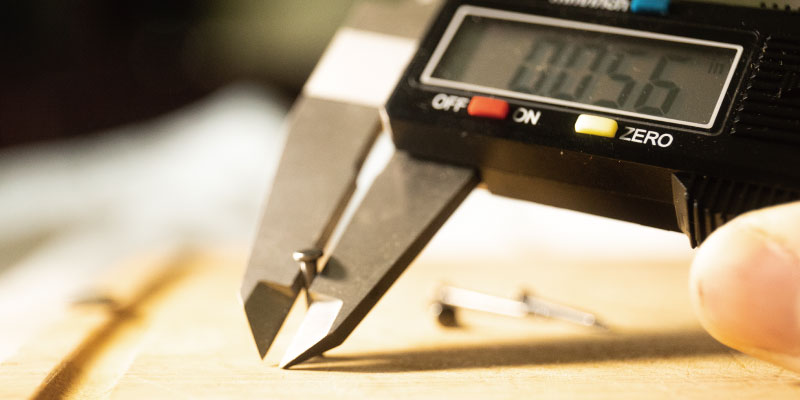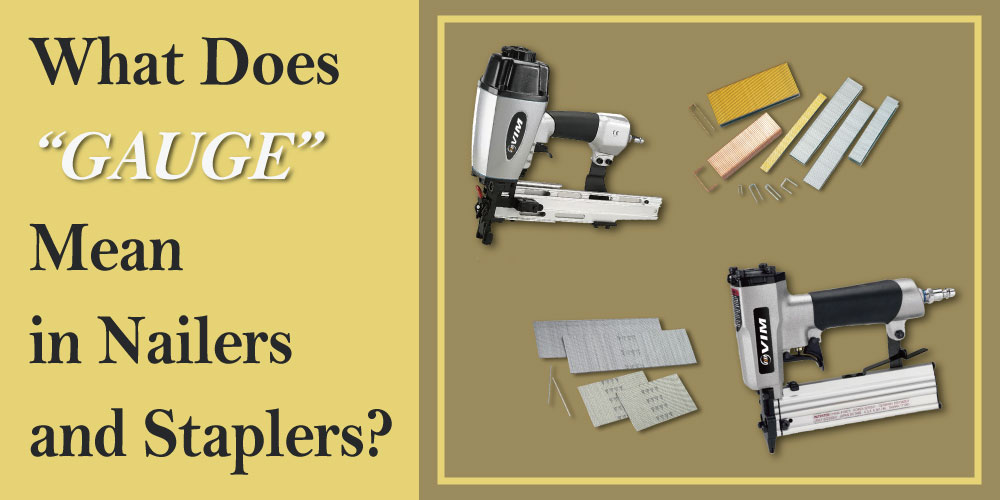Not Sure Which Gauge to Use? These 4 Points Make It Easy

In fastening applications, understanding nail gauge and staple gauge is key to selecting the right nailer or stapler for the job. Whether you're dealing with brad nails, pin nails, or different types of staples, the nail gauge or staple gauge plays a critical role in determining both the appearance and strength of the final result.
In this guide, we’ll walk you through what gauge really means, how it affects fastener performance, and how to select the best option based on material, holding power, and surface finish. From professional framing tasks to precise furniture detailing, matching the correct gauge with a compatible gauge nailer or gauge stapler ensures your work meets both structural and aesthetic standards.
What Does "Gauge" Mean in Nailers and Staplers?
 In the context of nailers and staplers, "gauge" refers to the width x thickness of wire for staples—or diameter for nails—of the fastener being used. The higher the gauge number, the thinner the nail or staple. For example, a 16-gauge nail is thicker and stronger than an 18-gauge one.
In the context of nailers and staplers, "gauge" refers to the width x thickness of wire for staples—or diameter for nails—of the fastener being used. The higher the gauge number, the thinner the nail or staple. For example, a 16-gauge nail is thicker and stronger than an 18-gauge one.
Understanding nail gauge and staple gauge is essential for choosing the right tool for the job. Thinner gauges are ideal for delicate trim work or upholstery, where minimal surface damage is critical. On the other hand, thicker gauges provide better holding power for heavy-duty tasks like framing or sheathing. Whether you're selecting a nailer or a stapler, matching the gauge of the fastener to your material and application is crucial to achieving both durability and a professional finish.
How to Choose the Right Gauge for Your Project?
 Choosing the correct fastener gauge is critical to achieving the best results in both finish and structural integrity. Understanding how nail gauge and staple gauge relate to material, function, and finish quality will help you make the right decision. Here's how to choose the most suitable option for your project.
Choosing the correct fastener gauge is critical to achieving the best results in both finish and structural integrity. Understanding how nail gauge and staple gauge relate to material, function, and finish quality will help you make the right decision. Here's how to choose the most suitable option for your project.
Consider the Application Type
Different applications call for different fastener gauges. Choosing the right tool—whether it's a gauge nailer or gauge stapler—starts with understanding the demands of your task.
- Heavy-duty projects
For structural framing, subflooring, or installing baseboards, a 15 or 16 gauge nailer offers the holding strength necessary for load-bearing applications.
【Related product: T50H】 - Medium-duty projects
Tasks such as attaching cabinet backs or wall paneling are well-suited for a 16 or 18 gauge stapler, which provides a good balance between grip and surface protection.
【Related product: Wide Crown Stapler, Narrow Crown Stapler】 - Fine finish or delicate work
For detailed trim, crown molding, or upholstery, 20-23 gauge stapler and 21-23 gauge nailer delivers a cleaner look with smaller holes—ideal for finishing work where appearance matters.
【Related product: Fine Wire Stapler, 21 & 23 Gauge Pin Nailer】
【Extended reading: Everyone Needs to Know the Complete Guide to Wide Crown Staplers】
Match the Tool with the Fastener
Make sure your nailer or stapler is compatible with the specific gauge range you're using. Tools are typically designed to accept a fixed or limited range, and using the wrong gauge can lead to misfires or jamming.
Assess the Holding Strength vs. Finish Quality
Gauge choice often comes down to a trade-off between strength and aesthetics. To select the right nail gauge or staple gauge, it’s important to evaluate which factor—durability or visual cleanliness—is more critical for your project.
- Stronger holding power
A lower gauge (i.e., thicker fastener) provides more grip, making it ideal for structural or high-stress connections. The trade-off is a more visible fastener hole. - Cleaner finish
A higher gauge (i.e., thinner fastener) is less obtrusive and better for visible surfaces but offers less mechanical strength.
【Extended reading: Air Pinner Buying Guide - 6 Points to distinguish Air Pinner and Finishing Nailer】
Factor in the Material Density
The density of the material you're working with will influence your gauge selection.
- Hardwoods
Use a lower nail gauge or staple gauge (thicker fasteners) for effective penetration and holding. - Softwoods or MDF
Opt for higher gauge fasteners (thinner) to avoid splitting or surface damage while maintaining adequate grip.
【Extended reading: What is Finishing Nailer? Differences Between Brad Nailer and Finish Nailer】
FAQ About Gauge
 Understanding staple and nail gauge is essential when choosing the right fastening tools and fasteners for your job. Below are some frequently asked questions to guide your selection of the most suitable nail gauge or staple gauge for various applications.
Understanding staple and nail gauge is essential when choosing the right fastening tools and fasteners for your job. Below are some frequently asked questions to guide your selection of the most suitable nail gauge or staple gauge for various applications.
Does the Gauge of Staples Affect the Crown Size?
The gauge of staples refers to the cross-sectional size of the wire—specifically its thickness x width—used to form the legs of the staple. The crown size, on the other hand, refers to the width of the staple’s top bridge. These two specifications are independent. That means you can have the same crown available in different staple gauges. When selecting a staple gauge, make sure it suits both your material needs and the crown dimensions your gauge stapler is built for.
Is a Lower Gauge Always Better?
Not necessarily. A lower gauge (thicker fastener) provides stronger holding power and is ideal for heavy-duty applications. However, for fine finish work, higher gauge nailers or staplers are preferred to reduce surface damage.
How Do I Know Which Gauge is Right for My Project?
Consider the material you are working with, the visibility of the fastener, and the level of strength required. Use lower gauges for structural or heavy-duty jobs, and higher gauges for delicate or visible finish work.
Conclusion
Selecting the right fastener gauge isn't just about numbers—it's about matching the right tool and fastener to the needs of your material, your project goals, and your finish expectations. Whether you’re using a 15 gauge nailer for framing or a 23 gauge stapler for fine trim, understanding how gauge impacts performance gives you better control over the outcome.
Use this guide as a reference when comparing nail gauge and staple gauge options, and always check your tool compatibility before loading fasteners. By choosing the appropriate gauge nailer or gauge stapler, you’ll not only improve fastening reliability but also elevate the overall quality of your work. If you’d like to learn more about nail and staple gauge, or need personalized recommendations for choosing an air nailer or stapler, feel free to contact us—we’d be happy to help.
Article Classification
Recent Articles
- The 4 Carton Staples Issues Ruining Your Packaging—Solved in Minutes
- 5 Reasons Why VIM Concrete T Nails Deliver Unmatched Grip and Durability
- The Hidden Force in Every Staple: 9 Point Types That Make Fastening Last
- 8 Expert Facts on Strip Nails for Smarter Fastening Choices
- From Car Seats to Fences: 3 Points to Choose the Perfect Hog Ring Size

